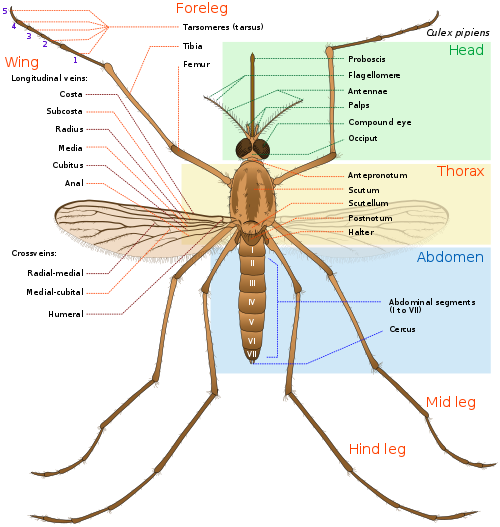Polluting agent: Plastic
Plastics are a growing form of pollution found in ecosystems at sea, fresh water and on land. Since there are multitudes of microplastics in the water, it's inevitable that they are absorbed by organisms and thus enter the food chain.
Recent reports claim that there will be 50 times more microplastics in the oceans in 2100..
So far, research has mainly been done on the impact of microplastics on sea's and much less on what happens in fresh water.
A new insight
There is a new study from the University of Reading showing evidence for the first time that this may indeed be the case, and that a large quantity of the microplastics that end up in fresh water in mosquito larvae also remain in the body as the larva becomes a doll, and also when she comes out of the doll as an adult mosquito.
_Total_preparation%20_larva.jpg)
©Doc. RNDr. Josef Reischig, CSc. • CC BY-SA 3.0
In this way, the microplastics can be released from the fresh water in the food chain on land (or in the air). Animals such as bats, birds, spiders and other insects that eat the adult mosquitoes, get the microplastics inside, and then also the animals that in turn eat the spiders, birds, et cetera.
Fluorescent microplastics
Most larvae of insects are especially ravenous and that also applies to mosquito larva. Some of them just swim through the water with their mouth parts open, and work everything inside which isn't too big. In this way it is as good as inevitable that they also get microplastics when they are in the water.
To find out what happens to the microplastics during the life cycle, the development from the egg cell to the adult state of the mosquitoes, and to see if they could pass those plastics from the larval stage to the adult stage, a team from the University of Reading in the UK bred mosquitoes in water with fluorescent microplastics.
The team chose Culex pipiens because that type of mosquito is very widespread.
Culex pipiens, the common mosquito, occurs on all continents outside of Antarctica, and fluorescent microplastics (2 micrometers to 15 micrometers) were chosen for easy follow-up in the different growth stages.

©Mariana Ruiz Villarreal LadyofHats - Public domain
From the breeding cups, larvae were then taken after the third molt, dolls, and adult specimens. The larvae were found having absorbed microplastics, and they were mainly collected in the Malpighi tubes; organs in insects that ensure the removal of waste from the digestive system.
The microplastics were also still present in the dolls and in the adult mosquitoes, although there was a difference between the small and the larger microplastics. The microplastics of 2 thousandths of a millimeter were able to move smoothly from one stage to the other, while only a small quantity were retained in the 15 micrometer particles.
Another source of pollution
Although the team has only researched the transfer of microplastics in a laboratorium, it's highly likely that this is going on in the wild.
"The importance of this is that it is very likely to be widespread," Amanda Callaghan told the AFP news agency. Callaghan is a biologist at the University of Reading and the main author of the new study.
"We only looked at mosquitoes as an example, but there are a lot of insects that live in water and have the same life cycle, with larvae that eat things in the water, and then emerge as adults," she said.
According to Callaghan, the scale of the problem is not yet clear and is still being investigated. "It is a very big problem, and the plastics that are already in the environment are going to linger with us for a very long time", she concluded.
The study from the university team is published in "Biology Letters" which can be found here:
http://rsbl.royalsocietypublishing.org/content/14/9/20180479
A message to the community
I included the #cleanplanet tag to emphasize how fantastic and important their work is. Pollution is mostly visible but has the potency to be a slow and very lethal poison if left lingering in the environment.
References
http://rsbl.royalsocietypublishing.org/content/14/9/20180479
Wikimedia Commons
This post has been voted on by the steemstem curation team and voting trail.
There is more to SteemSTEM than just writing posts, check here for some more tips on being a community member. You can also join our discord here to get to know the rest of the community!
Wow thanks!
Posted using Partiko Android